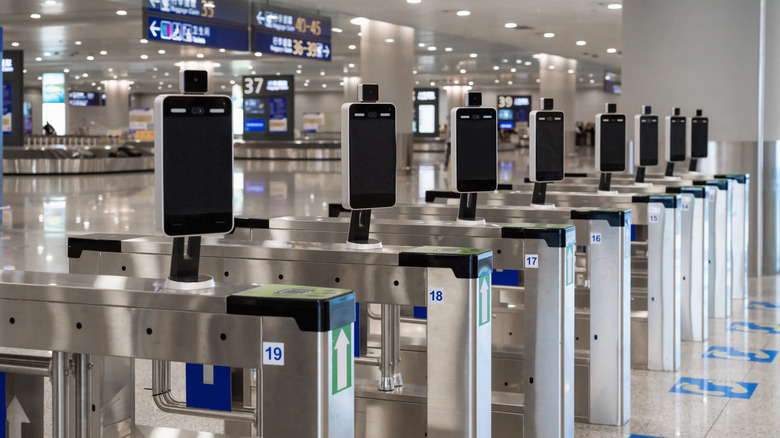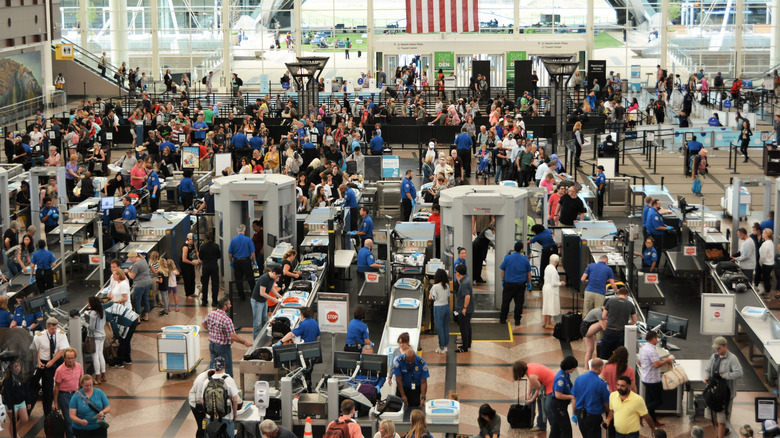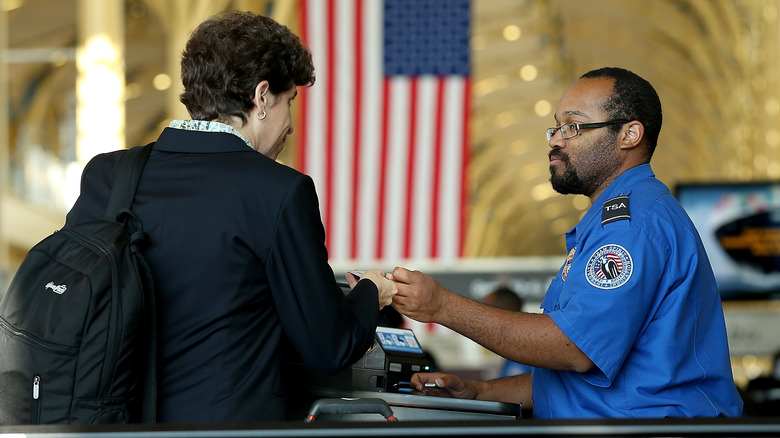Here's Why TSA Might Try To Take A Picture Of You
When you enter the security area in an airport, you'll likely notice signs urging you to not take photos. However, this rule doesn't apply to the Transportation Security Administration (TSA) itself. In some airports, TSA has set up cameras to snap a picture of each traveler going through the checkpoint.
Your first time encountering the cameras can be jarring, though TSA snapshots are likely to become more commonplace over time. Currently, over 80 airports across the country have camera stations at security checkpoints, a number that's set to eventually expand to over 400 U.S. hubs. So what are the cameras for, and why does TSA want to take a picture of you? The portrait shots are part of TSA's facial recognition technology screening, which is intended to confirm travelers' identity easily and quickly. All you need to do is scan an accepted form of identification and stand still to take a picture of your face. The system then confirms that your face matches the one found on the ID.
The photo kiosks don't eliminate security officers, who still stand by to assist travelers. However, they may be more effective than humans at helping you get through airport security faster. As Melissa Conley, a TSA executive director, told The New York Times, "People are not good at matching faces. It's just known. [...] Machines don't get tired."
Is TSA's facial recognition technology trustworthy?
If the government snapping your photo every time you fly makes you a little nervous, you're not the only one. Some groups, including the Electronic Privacy Information Center (EPIC), consider the technology to be a threat to privacy and civil rights. Specifically, EPIC warns that the U.S. doesn't have laws that place limits on facial recognition and that how TSA and other federal bodies use the data could change over time. Other organizations and civil rights activists have suggested that facial recognition machines may be more likely to misidentify people of color and non-binary travelers.
However — for now, at least — TSA representatives insist the photos pose no risk to fliers. In 2022, Jason Lim, an identity management capability manager at TSA, told The Washington Post that the photos are used to make a match before being erased from the system (though snapshots may be stored for up to 24 months during testing periods). Lim also noted that small changes in appearance shouldn't throw off the facial recognition machines and that misidentification "is not happening" with the current technology. TSA also states on its website that the photos aren't used for surveillance purposes and aren't shared with law enforcement.
How to opt out of having your picture taken
No matter where you stand on facial recognition technology, you don't have to allow TSA to take your picture if you don't want to. Machine-assisted photo matching is a completely elective part of the airport security process. TSA ensures that travelers who decline to have their photo taken will be treated with respect and should not face any negative repercussions on behalf of the security officers.
If you wish to avoid the cameras and opt out of using facial recognition technology, simply tell the officer standing near the cameras that you don't want your photo taken. They'll turn the camera off and manually confirm your identity. Be prepared to have a form of photo identification ready, such as a passport or Real ID. Notably, travelers under the age of 18 are never subject to the photo screenings.
Be aware that you may still encounter other forms of facial recognition technology when visiting the airport. For instance, some airlines use face scanners to help passengers skip the lines at the airport bag-check counter. Once the flier's face is matched with their ID, they can drop off their bag and head to their gate. Facial recognition cameras are also commonly used to speed up airport immigration lines. Depending on where your travels take you, you may be able to turn down these screening methods. Speak with a staff member or immigration officer to discuss alternatives.


